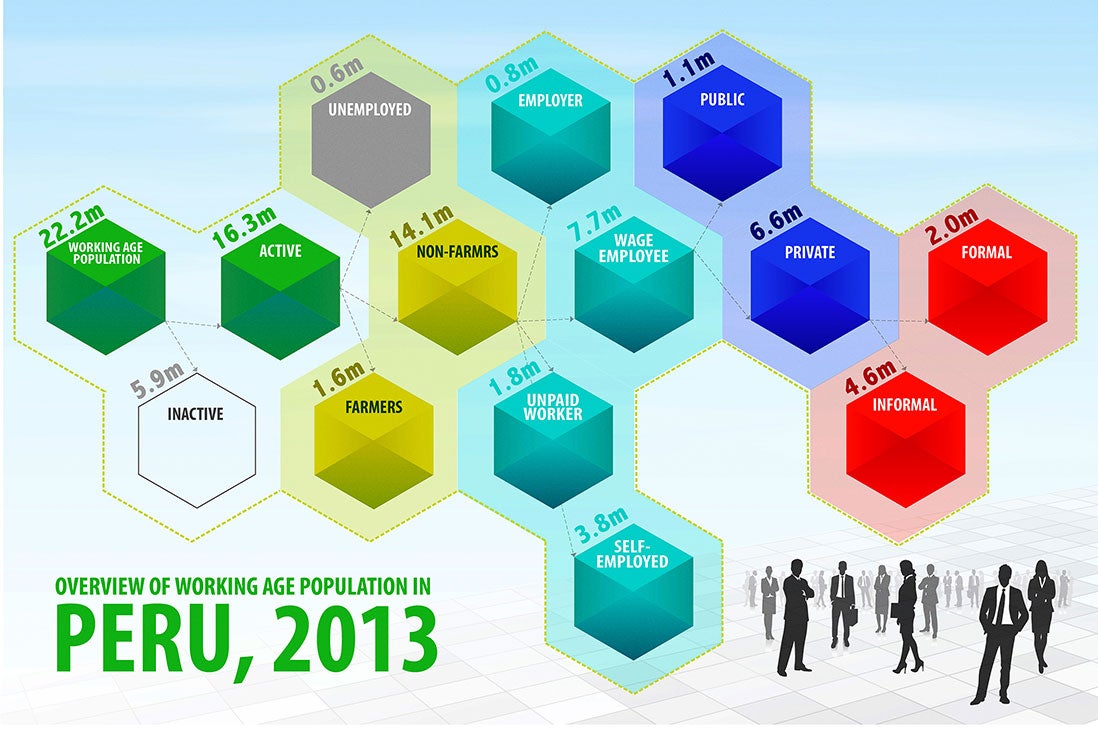
Infographic: high resolution
Since 2002, Peru has had strong economic performance: annual GDP growth averaged 6.4%, while employment grew by 2.4% each year. Although this was sufficient to absorb Peru’s growing working age population and labor force, when we compare this with other countries in the region, Peru’s economy created relatively fewer jobs given its high rate of growth. On the upside, the average productivity of these jobs rose. This should be good for growth and good for job quality.
What does the data show?
- Productivity gains due to upgrading and reallocation. In the last decade, Peru’s economic transformation was accompanied by major structural shifts in employment, from agriculture to services,and from rural to urban areas. Both of these shifts helped to boost aggregate labor productivity, which grew by 3.7% per year during 2002-2012. In addition to strong worker reallocation effects from informal agriculture to informal service jobs and formal service jobs, close to half of these aggregate gains were explained by productivity gains within the services sector. This translated into a widespread improvement in the quality of low productivity jobs.
- Urban-centered job creation in low-productivity sectors. Post-2006, most job creation was in cities, primarily in the low productivity sectors of wholesale and retail trade, government services, transport and construction jobs. Nevertheless, 60% of the jobs added were in the formal sector, meaning better jobs with higher wages and higher productivity levels.
- Primacy of informal work. Despite these recent gains, however, nearly four-fifths of Peru’s employment is informal work within low productivity activities. Farmers, the self-employed and informal wage workers each account for one-fourth of total employment. Although half of all workers earn a salary, 60% of these are informal wage workers receiving no social protection coverage. Moreover, informal wages are 60% lower than formal wages, controlling for other factors.
- Unequal opportunities. Peru’s labor market segmentation is not limited to the formal:informal divide. There is evidence of significant gender, age and regional differences as well. Women earn 60% less than men with similar skill and sector profiles, and are more likely to be in low quality jobs. Youth are more likely to be unemployed than older workers. The Costa region has relatively poorer job opportunities compared to the Sierra and Selva regions, and workers in Lima earn a 36% wage premium, all else being equal.
- Dynamism but segmentation too. Our analysis points to a dynamic yet segmented labor market. Movements in and out of inactivity and unemployment and between jobs are common in Peru, but transitions from informal to formal jobs are rare. Within a given year, around one-third of the inactive population enters the labor market, most of whom fail to obtain a good job. One-third of new entrants become self-employed, another third become informal wage employees, and 16% become farmers.
Not surprisingly, formal sector jobs are the most sought after due to their higher salaries, benefits coverage (e.g., social security) and stable contracts. But only 5% of informal workers successfully move into a formal job each year. Having more education increases the likelihood of landing a formal sector job, but the effect is small. The combined evidence suggests that labor supply is not the main culprit behind the small share of formal jobs; it is demand side and regulatory constraints that preclude more dynamic job creation in the formal sector.
Rigid labor regulations. Peru’s rigid rules for dismissal not only constrain firm’s capacity to adjust employment levels to changes in market demand, they also dissuade hiring in the first place. Evidence that labor restrictions are indeed binding is reflected in the fact that more and more firms within the formal private sector are offering fixed-term rather than open-ended contracts. The tax-wedge in Peru is also high by regional standards, another disincentive for firms to create formal jobs.
Other distortions affect firm growth. Dismissal regulations do not apply to small firms, which might explain why small businesses tend to remain small. Employment growth in formal firms in Peru has been relatively slow, based on survey data on registered firms. Whatever the factors limiting formal firms’ expansion, access to good jobs is particularly limited outside of Lima and Callao. The largest firms – those with over 500 employees – account for 60% of total formal employment, but large firms are not necessarily more productive; in fact, the evidence suggests that more productive firms are less likely to grow. What does this imply? A suboptimal allocation of workers: more workers are employed in less productive firms, while relatively few workers are employed in the most productive, small firms.
Looking ahead
Whereas past job growth was adequate to absorb new labor force entrants, current and future demographic pressures will require continued GDP growth of 6% per year and the creation of 2.9 million additional jobs by 2020 (2013 employment stood at 15.7 million) to avoid higher unemployment. Higher growth goes hand-in-hand with more jobs and better jobs, and inclusive growth brings income and welfare gains for excluded populations. How can the Peruvian economy achieve these goals?
The challenge is three-fold: creating new higher productivity jobs, raising the productivity level of existing – mostly informal – jobs, and increasing access to good jobs. An integrated “Jobs+” strategy is needed, one that goes beyond traditional policies to promote investment and growth but also introduces more flexibility in hiring and firing decisions, minimizes the incentives for informal work or for businesses to remain small, enhances education access, skills development and active labor market programs to connect workers to jobs or help them transition from low to higher productivity jobs, and strengthens the social protection system to address income risk for the most vulnerable workers.





Join the Conversation